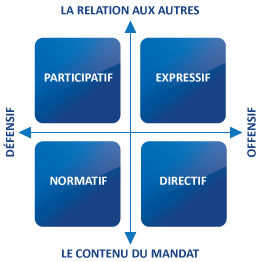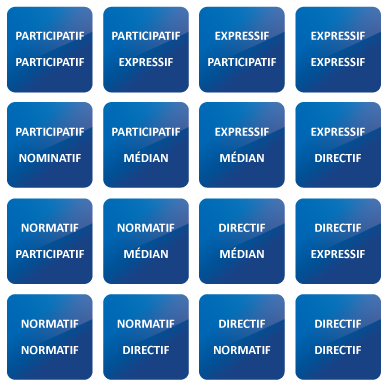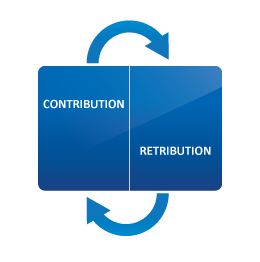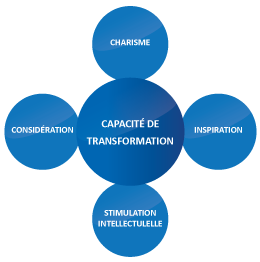

Une approche inspirée des recherches initiées par James McGregor Burns, Bernard M. Bass mais aussi de Platon, de Socrate, de Carl G Jung et de Freud et bien d’autres…..
L'évaluation porte sur :
1. L'orientation naturelle et l’importance accordée à la relation aux autres versus le management du contenu du mandat, la réalisation de l’activité
2. La tendance à se mettre en avant /à se mettre en position offensive versus la tendance à se mettre en retrait /à se mettre en position défensive
Il existe 4 combinaisons primaires
EXPRESSIF : Relation aux autres - Offensif
PARTICIPATIF : Relation aux autres - Défensif
DIRECTIF : Contenu du mandat-Offensif
NORMATIF : Contenu du mandat-Défensif

Il existe 16 combinaisons secondaires

Le Leadership se construit sur le statut (Potestas) - le pouvoir est accordé en raison de la nomination - ET sur la compétence personnelle (Auctoritas) - l’autorité est accordée en raison des compétences reconnues par les collaborateurs, pairs et hierarchie pendant l’exercice des fonctions -.
Le test évalue votre leadership sous l’angle de la capacité personnelle (Auctoritas), il évalue votre leadership de Transaction et votre leadership de Transformation.
1. Le Leadership de Transaction

Ce leadership est fondé sur un échange « donnant donnant », une transaction: le leader offre des récompenses à ses subordonnés sous la forme de rémunération, promotion ou de prestige (voire une sanction) en échange d’un travail effectué par ses subordonnés.
Le leader se situe dans une ligne hiérarchique classique, il fixe les objectifs et donne des instructions pour les réaliser. Il répond aux premières strates des besoins fondamentaux des subordonnés (cf. : Maslow) et donc de l’ici et maintenant. Il est basé sur l’offre et la demande extrinsèque du système économique.
2. Le Leadership de Transformation

Ce leadership est fondé sur un partage : le leader prend en compte la satisfaction des besoins intrinsèques de ses subordonnés, leurs besoins particuliers et spécifiques.
Le leader offre une vision claire et convaincante, optimiste et confiante et porteuse de sens (Inspiration), il fait preuve d’attention personnalisée, de pédagogie et de soutien (Considération), il ouvre sur de nouveaux paradigmes et favorise l’innovation et la créativité (Stimulation Intellectuelle).Il communique non seulement sur ses valeurs et éthiques mais aussi les incarne dans son rôle (Charisme).
Les deux types de Leadership sont nécessaires et complémentaires, le leadership transformationnel se construit sur la base d’un leadership transactionnel et non pas le contraire. Le leadership transformationnel peut être amélioré, par la formation, en sensibilisant les leaders aux dimensions qui permettent d’élaborer, de communiquer et de renforcer une vision commune. Il est devenu le type moderne de Leadership, il a un impact sur l’engagement des personnes et transforme les organisations.
Chaque style managérial et chaque type de leadership apportent leur contribution à l’équilibre des personnes et des organisations. La surreprésentation dans les effectifs d’un style managérial et/ou d’un type de leadership ou a contrario la sous-représentation peut potentiellement conduire à des difficultés et être nuisible. La complémentarité et la diversité des talents et leurs utilisation a bon escient garantissent une meilleure probabilité de succès et de pérennité des personnes et des organisations.